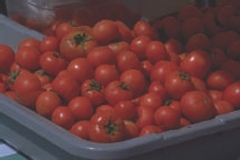
The "certification" of tomato fields

The project, realized by Planetek Italia and the CON.CO.O.SA cooperative (an organization of horticulturist of Salerno), has allowed to develop a methodology of "certification" of the tomato fields using Landsat satellite images.
The results of the analysis are thematic maps, related to the area object of the study, that indicate, for each field declared to tomato, the probability percentage about the real presence of the crop. Every year, in fact, the horticulturists make expectations about the quantity of tomatoes to be produced, indicating the areas that will be cultivated and, basing on these forecasts, they require to the AGEA (the agency for funding in agriculture), through the associations and organizations of the producers, the funding of the crop foreseen.
On the basis of the report of the horticulturists, AGEA starts verifications. If land surveys underline any difference exceeding the admitted tolerance, compared to the report provided, the same AGEA applies a proportional reduction of the financing that hits all the producers of the cooperative.
This plan has allowed to define an analysis procedure that allows to the association of producers to underline and correct possible anomalies in relation to the reports, with great advance compared to the AGEA verifications, thus protecting the interests of all the associates.

The test
The experimentation has been carried on a test area in Foggia (Italy) where an elevated concentration of tomato producer is present.
A number of Landsat ETM images have been used to cover the whole period form the transplantation to the harvest.
The remote sensed data have been used to produce land use maps. The classified maps have progressively provided information about the presence of crops, allowing the operators of CON.CO.O.SA. to plan and distribute the land survey activities during the time.
The picture above and the picture beside show some phases of the processing of Landsat ETM images of the zone of Foggia.
The maps obtained from the processing of satellite images (picture down) have been integrated in a Geographic Information System and the crossing with the data collected on field, available at the association, has allowed the extraction of the greatest informative content from the satellite data.

Conclusions
It must be underlined that the results of the project, already satisfactory both in terms of accuracy and in realization speed, will better more and more with the repetition of the monitoring activities in the next years.
That derives from an improvement of the cognitive level of the areas examined, from a great improvement in the knowledge of the crop and of his interaction with the environment and with the farming practices (that may be really different in the different cultivation area) and from an improvement of the informative flow.
In this latest case, the preparation of the database in advance, the definition of specific agreements with the data providers, the optimization of the informative flow deriving from the land surveys, also with the aid of GPS systems and wireless communication systems, the collection of on field data in the same day and hour in which the passage of the satellite is expected, allow to reduce the results release time, essential element for the operational use of
the results achieved.
In the years following the experimentation, the number of verifications on field to support the classification will progressively reduce with a relative reduction of the costs.
Project information
Client information:
--
Application fields:

